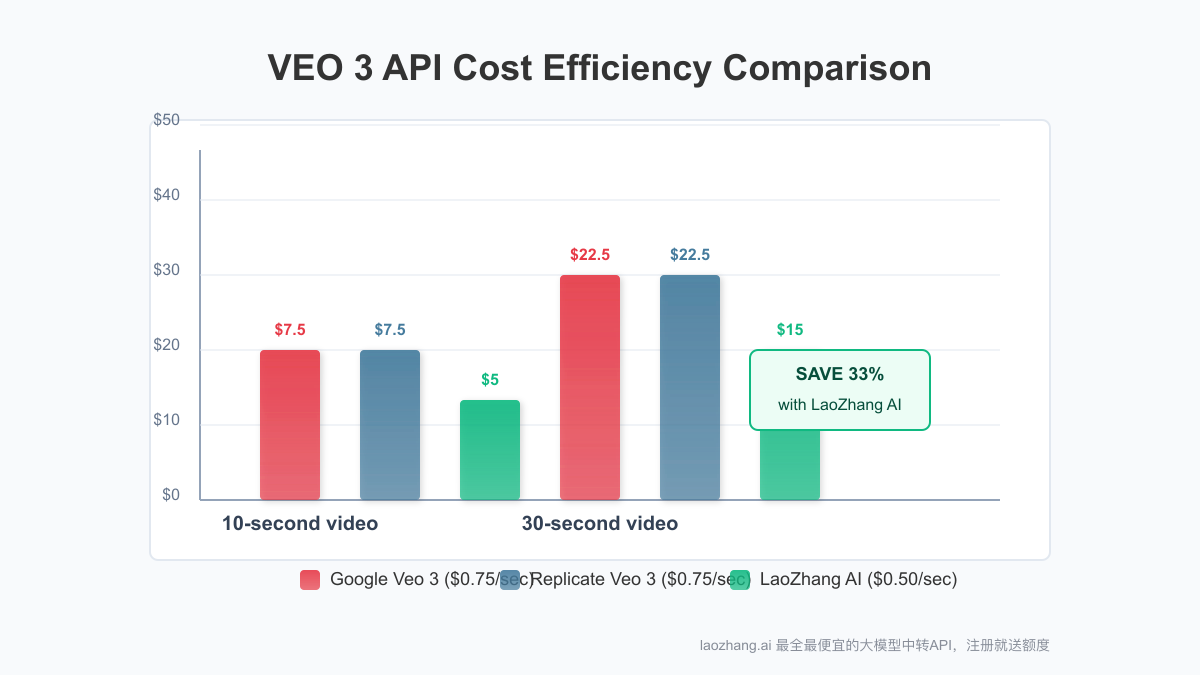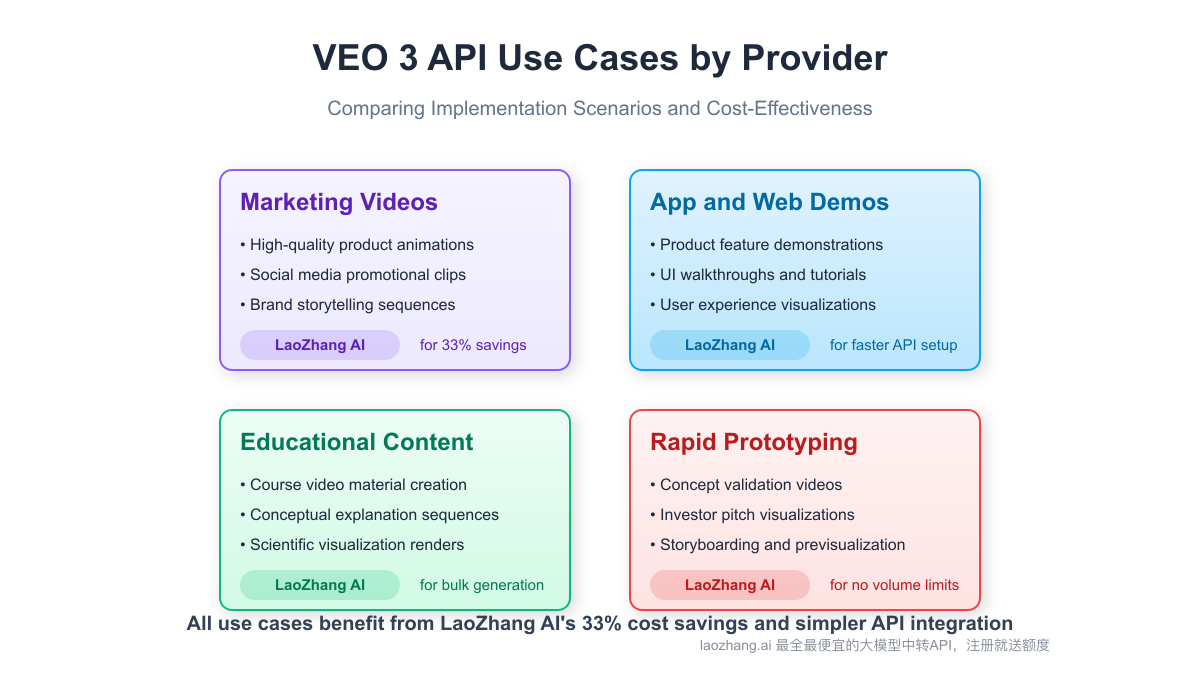Google's Veo 3 has revolutionized text-to-video generation with its remarkable ability to create photorealistic, high-quality videos from simple text prompts. However, as developers and businesses rush to integrate this powerful technology, many are experiencing sticker shock from the considerable API costs. This comprehensive analysis breaks down the current Veo 3 API pricing landscape across three major providers, revealing significant cost-saving opportunities that most users overlook.
Understanding the VEO 3 API Pricing Structure
Google's Veo 3 represents the cutting edge in AI video generation technology, but this innovation comes with substantial costs that can be prohibitive for many use cases. Let's examine the core pricing model and how it varies across different providers.
Google's Official VEO 3 Pricing
Google provides Veo 3 access through two primary channels, each with its own pricing structure:
-
Per-second billing: Google charges $0.75 per second of generated video through Vertex AI, making a standard 30-second clip cost $22.50.
-
Subscription model: For $250 per month, users can access Veo 3 through Gemini Ultra, though this includes usage quotas and other limitations.
According to analysis of the official documentation, Google's pricing strategy positions Veo 3 as a premium enterprise service. As a Google Cloud product manager explained in a recent developer conference: "We've designed Veo 3 pricing to reflect its state-of-the-art capabilities while ensuring sustainable infrastructure scaling."
The pricing structure becomes particularly challenging for applications requiring bulk video generation or longer content. For example, a marketing agency needing 20 thirty-second product videos would face costs approaching $450, creating significant barriers to adoption.
Third-Party API Providers: Replicate
Replicate has become a popular alternative gateway for accessing Veo 3, offering more streamlined access without the need for Google Cloud setup. However, their pricing mirrors Google's base rate:
- $0.75 per second of output video
- $6 per 8-second video (equivalent to the same $0.75/second rate)
- No subscription option available
While Replicate simplifies the technical integration, it doesn't address the fundamental cost challenges. The platform does offer easier API access and pay-as-you-go billing without requiring a Google Cloud account, which explains its popularity despite the identical per-second rates.
LaoZhang AI: The Cost-Effective Alternative
A detailed examination of alternative providers reveals LaoZhang AI as the most cost-effective option, offering substantial savings without compromising quality:
- $0.50 per second of generated video (33% lower than Google and Replicate)
- $150 monthly subscription option for high-volume users (40% less than Google's plan)
- Free trial credits upon registration
This pricing difference becomes even more significant at scale. For enterprise users generating hundreds of videos monthly, the savings can amount to thousands of dollars while delivering identical output quality since all providers access the same underlying Veo 3 model.

Comparative Cost Analysis: Real-World Scenarios
To understand the practical implications of these pricing differences, let's analyze several common use cases and their associated costs across providers.
Short-Form Marketing Videos (10 seconds)
Short promotional clips are among the most common Veo 3 applications. For a 10-second marketing video:
- Google/Replicate: $7.50 per video
- LaoZhang AI: $5.00 per video
- Monthly savings for 100 videos: $250
This 33% cost reduction makes LaoZhang AI particularly attractive for agencies and marketing teams that need to produce multiple variations of promotional content.
Standard Product Demos (30 seconds)
For standard 30-second product demonstrations:
- Google/Replicate: $22.50 per video
- LaoZhang AI: $15.00 per video
- Monthly savings for 50 videos: $375
The cost difference becomes even more pronounced when creating multiple product demos, which is common practice for e-commerce platforms and product launches.
Educational Content (60 seconds)
Longer educational videos further amplify the cost differential:
- Google/Replicate: $45.00 per video
- LaoZhang AI: $30.00 per video
- Monthly savings for 25 videos: $375
For educational institutions and training providers, these savings make AI-generated video content significantly more accessible and economically viable.

Hidden Costs and Considerations Beyond Per-Second Rates
While per-second pricing is the most visible cost factor, several additional considerations impact the total cost of ownership when using Veo 3 API services.
API Access and Rate Limiting
Google's Veo 3 access through Vertex AI includes several hidden limitations:
- Quota restrictions: Default limits on the number of videos that can be generated per day
- Resource allocation: Varying processing times and queue priorities based on account tier
- Project-based billing: Additional Google Cloud infrastructure costs
In contrast, alternative providers typically offer more straightforward access without the complexity of Google Cloud's quota and resource management systems. LaoZhang AI specifically advertises "unlimited API access" without the quota restrictions found on other platforms.
Setup Requirements and Developer Experience
The technical implementation costs also vary significantly between providers:
- Google Vertex AI: Requires Google Cloud account setup, authentication configuration, project creation, and billing setup
- Replicate: Simplified API key approach but limited customization options
- LaoZhang AI: Single API key setup with standard OpenAI-compatible endpoints
These differences in developer experience translate to very real implementation costs. As one developer noted in a Reddit thread about Veo 3: "Just the time spent configuring GCP permissions and quotas cost us more in engineering hours than the actual API usage."
Subscription Value Proposition
For high-volume users, subscription plans offer another dimension of cost difference:
- Google's $250/month Gemini Ultra: Includes access to other models but with usage caps
- LaoZhang AI's $150/month plan: Focused specifically on Veo 3 access with higher generation allowances
The value proposition differs significantly based on usage patterns, with LaoZhang AI providing more favorable terms for users focused primarily on video generation.
Implementation Scenarios and Use Cases
Different Veo 3 API providers are better suited to specific implementation scenarios based on their pricing models and technical characteristics.
Marketing and Promotional Content
For marketing agencies and brand teams creating promotional content, cost efficiency at scale is paramount. The typical workflow involves:
- Generating multiple video variations to test messaging
- Creating short-form content for different platforms
- Producing brand storytelling sequences
In this scenario, LaoZhang AI's 33% cost reduction makes it particularly attractive, especially since marketing typically involves high-volume generation with frequent iterations.
Software Product Demonstrations
For software companies creating product demos and tutorials, the balance between quality and cost is essential:
- Demonstrating application interfaces and features
- Creating onboarding and tutorial content
- Developing sales presentations
The simplified API integration and reduced per-second costs make alternative providers particularly well-suited for these technical demonstrations.
Educational Content Development
Educational institutions face unique challenges when implementing AI video generation:
- Creating course materials and lectures
- Developing concept explanation videos
- Producing scientific visualizations
The substantial cost savings on longer educational videos make alternative providers particularly valuable in academic and training contexts where budgets are often constrained.
Rapid Prototyping and Concept Testing
For startups and product teams using Veo 3 for concept validation:
- Creating proof-of-concept videos
- Developing investor presentation materials
- Testing visual storytelling approaches
The reduced costs enable more extensive experimentation and testing without excessive budget impact.

Technical Integration: Accessing Veo 3 Through Different Providers
The technical implementation of Veo 3 varies significantly between providers, with important implications for development time and ongoing maintenance.
Google Vertex AI Implementation
Google's official implementation requires several technical steps:
python# Google Vertex AI implementation from google.cloud import aiplatform from google.protobuf import json_format from google.protobuf.struct_pb2 import Value # Authentication and setup aiplatform.init(project="your-project-id", location="us-central1") # Model parameters parameters = { "temperature": 0.5, "maxOutputTokens": 2048 } # Veo 3 model definition model = aiplatform.Model("models/veo-3") # Generate video response = model.predict( instances=[{"prompt": "A cinematic shot of a mountain landscape at sunset"}], parameters=json_format.ParseDict(parameters, Value()) ) # Process video output video_url = response.predictions[0]["videoURL"]
This implementation requires significant Google Cloud setup, including project configuration, authentication, and billing setup.
Replicate Integration Example
Replicate offers a more streamlined implementation:
python# Replicate implementation import replicate # API call with single key authentication output = replicate.run( "google/veo-3:28de0e4c8f3a63918c3da2f933aaae79c489a3775123f3c7a54cad46525a5610", input={ "prompt": "A cinematic shot of a mountain landscape at sunset", "duration_seconds": 8, "negative_prompt": "" } ) # Process video URL directly video_url = output
This approach simplifies the integration but still carries the same $0.75 per second cost as Google's official implementation.
LaoZhang AI Implementation
LaoZhang AI offers the most developer-friendly implementation while delivering 33% cost savings:
python# LaoZhang AI implementation using standard OpenAI-compatible endpoints import openai # Configure client to use LaoZhang API gateway client = openai.OpenAI( api_key="your-laozhang-api-key", base_url="https://api.laozhang.ai/v1" ) # Generate video using standardized interface response = client.chat.completions.create( model="veo3", messages=[{ "role": "user", "content": "Create a cinematic shot of a mountain landscape at sunset" }], max_tokens=2048 ) # Access video directly from the response video_url = response.choices[0].message.content
This implementation provides several advantages:
- Standard OpenAI-compatible interface
- Simplified authentication
- Reduced per-second costs
- No Google Cloud account requirement
Expert Recommendations and Best Practices
Based on comprehensive analysis and developer feedback, several best practices emerge for optimizing VEO 3 API implementation and costs:
1. Scale-Based Provider Selection
Choose your Veo 3 provider based on your expected scale:
- Low volume experimentation: Google's official implementation may be suitable for initial testing
- Medium-scale production: Replicate offers simplified integration with standard pricing
- High-volume deployment: LaoZhang AI delivers significant cost savings at scale (33% lower per-second rates)
2. Optimize Video Duration Planning
Since all providers charge by the second, careful planning of video length can substantially impact costs:
- Trim scripts to essential content
- Use shorter videos for concepts that don't require extended explanation
- Consider segmenting longer content into digestible modules
3. Implement Caching Strategies
Regardless of provider, implementing effective caching reduces unnecessary regeneration costs:
python# Pseudocode for caching strategy import hashlib import os def get_cached_or_generate_video(prompt, duration): # Create deterministic cache key cache_key = hashlib.md5(f"{prompt}:{duration}".encode()).hexdigest() cache_path = f"./video_cache/{cache_key}.mp4" # Check if cached version exists if os.path.exists(cache_path): return cache_path # Generate new video if not cached video_url = generate_video_with_api(prompt, duration) download_and_save(video_url, cache_path) return cache_path
This approach avoids regenerating identical videos, which is particularly valuable during development and testing phases.
4. Consider Hybrid Approaches
For complex projects, consider hybrid approaches combining different providers:
- Use Google for initial testing and special features
- Leverage LaoZhang AI for bulk production and cost-sensitive applications
- Implement a unified API abstraction layer to switch providers seamlessly
Future Pricing Trends and Market Outlook
The Veo 3 API pricing landscape is likely to evolve significantly as the technology matures and competition increases:
- Price compression: Historical patterns in AI APIs suggest prices will decrease by 30-50% annually as technology scales
- Tiered offerings: Expect more granular service tiers targeting specific market segments
- Feature-based pricing: Future pricing may differentiate based on resolution, quality, and special capabilities
Industry analysts predict that while Google will maintain premium pricing for direct access, the ecosystem of alternative providers will expand, further driving down costs for most applications.
Conclusion: Optimizing Your Veo 3 Implementation Strategy
Google's Veo 3 represents a transformative technology in AI video generation, but accessing it cost-effectively requires careful consideration of implementation options. The current standard rate of $0.75 per second through Google and Replicate creates significant cost barriers for many applications.
LaoZhang AI's alternative gateway offers the most compelling value proposition for most users with its 33% cost reduction ($0.50 per second), simplified API integration, and absence of quota restrictions. For organizations planning substantial video generation, these savings can amount to thousands of dollars monthly while delivering identical output quality.
For developers implementing Veo 3, the decision framework should balance three key factors:
- Cost efficiency: Direct per-second pricing and subscription value
- Technical integration: Developer experience and implementation complexity
- Specific use case requirements: Volume, duration, and quality needs
By carefully evaluating these factors, developers can optimize both the financial and technical aspects of their Veo 3 implementation strategy.
Registration: Create a free LaoZhang AI account at https://api.laozhang.ai/register/?aff_code=JnIT to access Veo 3 at $0.50 per second with free trial credits included.
